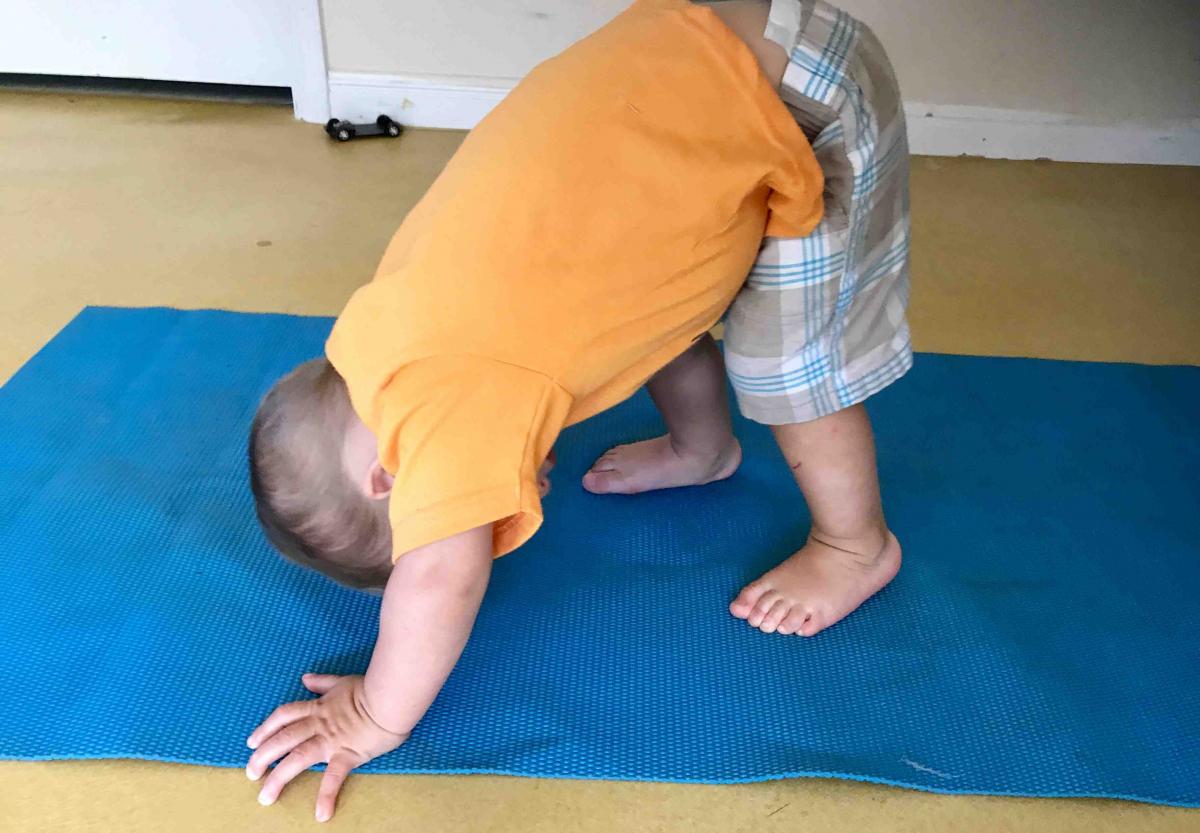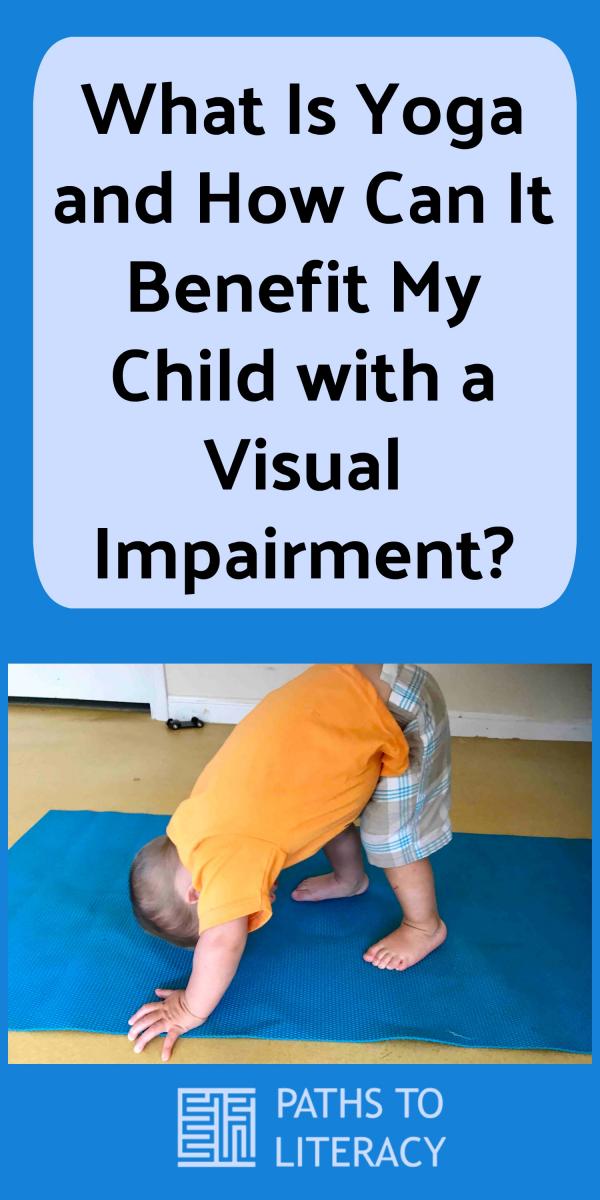What Is Yoga and How Can It Benefit My Child with a Visual Impairment?
 There has been a lot of talk about yoga lately. Many people tout the benefits of yoga, including improved energy levels, cardiovascular health, and increased flexibility. While the general public has seen dramatic results from incorporating yoga into their lives, yoga has even more benefits for children with visual impairments.
There has been a lot of talk about yoga lately. Many people tout the benefits of yoga, including improved energy levels, cardiovascular health, and increased flexibility. While the general public has seen dramatic results from incorporating yoga into their lives, yoga has even more benefits for children with visual impairments.
Yoga is a safe and effective exercise for children with visual impairments. Because of the gentle nature of this exercise and its tactile barrier of safety (our yoga mats), the exercise practice of yoga boasts a plethora of benefits for children with visual impairments.
When I first started teaching at TSBVI, the ever-wonderful Linda Hagood was teaching yoga to children with visual and multiple impairments. I was lucky enough to see first hand the miracles that were happening with our students. From better communication skills, self-determination skills, to increased literacy. Of course, as an Orientation and Mobility Specialist, I was most fascinated by the increased motor planning and spatial awareness skills.
This simple form of exercise has helped to shape hundreds of lives of children with visual impairments. It can help your child improve their life as well.
First of all, what is yoga?
Yoga is a form of exercise that focuses on both your body and your breath. The breathing component is what makes it so powerful as a tool to use after the yoga session is over. As a practice within our schools, yoga is NOT a form of religion or spirituality. It is simply a very accessible mode of exercise that is motivating, fun, challenging, and beneficial to people with visual impairments.
You may have been to a yoga class or seen one depicted on the media. Just like those classes, children often use yoga mats or other soft, non-slippery surfaces to practice. People move their bodies in different poses within this space to get exercise and to focus on their breathing. As with any exercise, yoga helps make you happy, gives your heart more power, and helps release stress. Aside from the exercise benefits, our children with visual impairments benefit greatly from this practice.
Benefits of Yoga for Children with Visual Impairments
1. Increases motor planning by having to learn new movements.
Yoga poses are not typical walking, sitting, standing postures. Many of the poses are new movements for our children. As you teach your child how to move in a new way, their brain is learning new ways to plan their movements. The brain creates new pathways with this new information. Then, as they begin to plan movements off of the mat, their brains can readily pull out the information about the new movement pattern. For example, if your child has been experiencing difficulty getting their backpack off their shoulders and onto their school chair, they may start to use the twist that they learned in yoga to help them move their body and put their backpack on their chair.
2. Increases body and spatial awareness by having to move your body in new ways.
When your child is asked to move one arm above their head, they may lift their arm out to the side. Yoga creates a safe space for the caregiver to gently help your child learn where “above” their body is. By helping the body move in to the correct place around their body and the proprioceptive feedback given to the brain from the position, the child then has a better understanding of where “above” her head is.
3. Increases communication skills when the child is asked to communicate during the session.
In typical yoga classes at a studio, a teacher often gives directions to the class and the class members move without talking. Yoga with children with visual impairments is wildly different than your “typical” class. In a yoga session with children with visual impairments, the children are often active participants in their literacy and communication. Not only are children often asked to engage with one another (if there is more than one student in the session), but they are also encouraged to engage with the teacher. They may be asked to make a choice between yoga poses, plan a story to be read within the yoga session, or engage in a conversation about the yoga session.
4. Increases self-determination skills by giving the students challenges that they can eventually overcome.
The inherent challenges that we face when we are asked to do something new facilitate self-determination skills. Many children find yoga poses to be a fun challenge. Once they learn how to do the pose, their sense of self-determination increases immeasurably! Any exercise program that you complete once a week for at least 12 weeks has scientifically been proven to increase your self-determination skills as well.
5. Increases literacy when stories, lists, and other literacy are infused.
When practicing yoga, many teachers use braille, large print, or tactile symbol lists to help their students practice literacy skills in a fun and engaging way.
Ready to try yoga with your child with visual impairments?
Try incorporating these three poses into their day. You can have a separate yoga session, or incorporate these poses into a “yoga break”, where they can do a little movement between seated activities.
Sunshine Breath
From seated:
- Bring your hands together so that your palms touch.
- As you breathe in, keep your hands together and lift your arms up towards the ceiling.
- As you breathe out, separate your hands out to the side and bring your arms down to your sides. (Teacher’s note: Have the child place their hands on either the ground or the seat of the chair).
- Continue with this breathing pattern for 5 breaths.
Reaching Mountain Pose
- Come to standing. (You can stand behind your chair, desk, or table if you were just sitting.)
- Lift your arms up towards the ceiling, strong and straight.
- Feel your belly get bigger when you inhale.
- Blow out and feel your belly come down.
- Have the student breathe in and out for 3-5 breaths.
Moon Pose
From standing with your arms above your head:
- Hold your hands together. Interlace your fingers. (Use other words such as “glue your hands together” if those concepts work better).
- Lean over to the left.
- Breathe in, feel your belly get better.
- Breathe out, feel your belly come down.
- Have the student breathe in and out for 3 breaths.
- Keep your hands together, arms strong and straight, and lean over to the right.
- Breathe in, feel your belly get better.
- Breathe out, feel your belly come down.
- Have the student breathe in and out for 3 breaths.
Note: Get creative and use the words that are appropriate for your individual student. For example, if a student does not know what a ceiling is, you may want to either use the teachable moment to explore a ceiling, or use the word “sky” instead.
Leave a comment below and let me know which pose was your child’s favorite. How did you work these poses into your child’s day? How did they make your child feel?


Comments
I am a visually impaired
Absolutely, Torie! The term
yoga
Yes- to ALL of this!!
Question, and a Resource
Hi Allison,
Nice blog post! Yoga is a